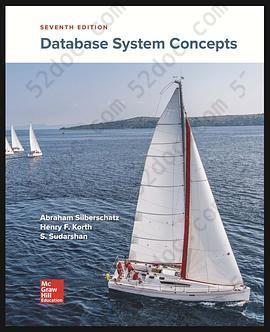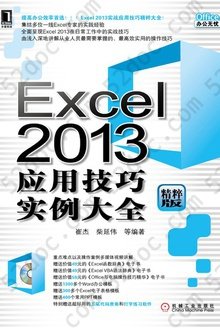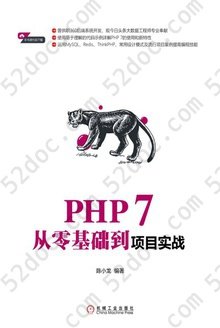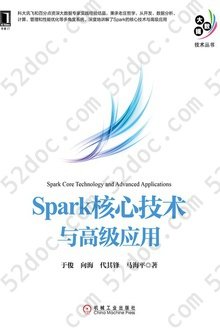注重体验与质量的电子书资源下载网站
分类于: 云计算&大数据 人工智能
简介

Database System Concepts: 7th Edition 豆 0.0分
资源最后更新于 2020-08-23 08:23:30
作者:Abraham Silberschatz Professor
出版社:McGraw-Hill Education
出版日期:2019-01
ISBN:9780078022159
文件格式: pdf
标签: 数据库 Database 计算机 CS 计算机科学 分布式 前沿 软件工程
简介· · · · · ·
Database System Concepts by Silberschatz, Korth and Sudarshan is now in its 7th edition and is one of the cornerstone texts of database education. It presents the fundamental concepts of database management in an intuitive manner geared toward allowing students to begin working with databases as quickly as possible.
The text is designed for a first course in databases at the ju...
目录
Chapter 1 Introduction
1.1 Database-System Applications 1
1.2 Purpose of Database Systems 5
1.3 View of Data 8
1.4 Database Languages 13
1.5 Database Design 17
1.6 Database Engine 18
1.7 Database and Application Architecture 21
1.8 Database Users and Administrators 24
1.9 History of Database Systems 25
1.10 Summary 29
Exercises 31
Further Reading 33
PART ONE RELATIONAL LANGUAGES
Chapter 2 Introduction to the Relational Model
2.1 Structure of Relational Databases 37
2.2 Database Schema 41
2.3 Keys 43
2.4 Schema Diagrams 46
2.5 Relational Query Languages 47
2.6 The Relational Algebra 48
2.7 Summary 58
Exercises 60
Further Reading 63
Chapter 3 Introduction to SQL
3.1 Overview of the SQL Query Language 65
3.2 SQL Data Definition 66
3.3 Basic Structure of SQL Queries 71
3.4 Additional Basic Operations 79
3.5 Set Operations 85
3.6 Null Values 89
3.7 Aggregate Functions 91
3.8 Nested Subqueries 98
3.9 Modification of the Database 108
3.10 Summary 114
Exercises 115
Further Reading 124
Chapter 4 Intermediate SQL
4.1 Join Expressions 125
4.2 Views 137
4.3 Transactions 143
4.4 Integrity Constraints 145
4.5 SQL Data Types and Schemas 153
4.6 Index Definition in SQL 164
4.7 Authorization 165
4.8 Summary 173
Exercises 176
Further Reading 180
Chapter 5 Advanced SQL
5.1 Accessing SQL from a Programming
Language 183
5.2 Functions and Procedures 198
5.3 Triggers 206
5.4 Recursive Queries 213
5.5 Advanced Aggregation Features 219
5.6 Summary 231
Exercises 232
Further Reading 237
PART TWO DATABASE DESIGN
Chapter 6 Database Design Using the E-R Model
6.1 Overview of the Design Process 241
6.2 The Entity-Relationship Model 244
6.3 Complex Attributes 249
6.4 Mapping Cardinalities 252
6.5 Primary Key 256
6.6 Removing Redundant Attributes in Entity
Sets 261
6.7 Reducing E-R Diagrams to Relational
Schemas 264
6.8 Extended E-R Features 271
6.9 Entity-Relationship Design Issues 279
6.10 Alternative Notations for Modeling
Data 285
6.11 Other Aspects of Database Design 291
6.12 Summary 292
Exercises 294
Further Reading 300
Chapter 7 Relational Database Design
7.1 Features of Good Relational Designs 303
7.2 Decomposition Using Functional Dependencies 308
7.3 Normal Forms 313
7.4 Functional-Dependency Theory 320
7.5 Algorithms for Decomposition Using Functional Dependencies 330
7.6 Decomposition Using Multivalued Dependencies 336
7.7 More Normal Forms 341
7.8 Atomic Domains and First Normal Form 342
7.9 Database-Design Process 343
7.10 Modeling Temporal Data 347
7.11 Summary 351
Exercises 353
Further Reading 360
PART THREE APPLICATION DESIGN AND DEVELOPMENT
Chapter 8 Complex Data Types
8.1 Semi-structured Data 365
8.2 Object Orientation 376
8.3 Textual Data 382
8.4 Spatial Data 387
8.5 Summary 394
Exercises 397
Further Reading 401
Chapter 9 Application Development
9.1 Application Programs and User
Interfaces 403
9.2 Web Fundamentals 405
9.3 Servlets 411
9.4 Alternative Server-Side Frameworks 416
9.5 Client-Side Code and Web Services 421
9.6 Application Architectures 429
9.7 Application Performance 434
9.8 Application Security 437
9.9 Encryption and Its Applications 447
9.10 Summary 453
Exercises 455
Further Reading 462
PART FOUR BIG DATA
Chapter 10 Big Data
10.1 Motivation 467
10.2 Big Data Storage Systems 472
10.3 The MapReduce Paradigm 483
10.4 Beyond MapReduce: Algebraic
Operations 494
10.5 Streaming Data 500
10.6 Graph Databases 508
10.7 Summary 511
Exercises 513
Further Reading 516
Chapter 11 Data Analytics
11.1 Overview of Analytics 519
11.2 Data Warehousing 521
11.3 Online Analytical Processing 527
11.4 Data Mining 540
11.5 Summary 550
Exercises 552
Further Reading 555
PART FIVE STORAGE MANAGEMENT AND INDEXING
Chapter 12 Physical Storage Systems
12.1 Overview of Physical Storage Media 559
12.2 Storage Interfaces 562
12.3 Magnetic Disks 563
12.4 Flash Memory 567
12.5 RAID 570
12.6 Disk-Block Access 577
12.7 Summary 580
Exercises 582
Further Reading 584
Chapter 13 Data Storage Structures
13.1 Database Storage Architecture 587
13.2 File Organization 588
13.3 Organization of Records in Files 595
13.4 Data-Dictionary Storage 602
13.5 Database Buffer 604
13.6 Column-Oriented Storage 611
13.7 Storage Organization in Main-Memory
Databases 615
13.8 Summary 617
Exercises 619
Further Reading 621
Chapter 14 Indexing
14.1 Basic Concepts 623
14.2 Ordered Indices 625
14.3 B+-Tree Index Files 634
14.4 B+-Tree Extensions 650
14.5 Hash Indices 658
14.6 Multiple-Key Access 661
14.7 Creation of Indices 664
14.8 Write-Optimized Index Structures 665
14.9 Bitmap Indices 670
14.10 Indexing of Spatial and Temporal Data 672
14.11 Summary 677
Exercises 679
Further Reading 683
PART SIX QUERY PROCESSING AND OPTIMIZATION
Chapter 15 Query Processing
15.1 Overview 689
15.2 Measures of Query Cost 692
15.3 Selection Operation 695
15.4 Sorting 701
15.5 Join Operation 704
15.6 Other Operations 719
15.7 Evaluation of Expressions 724
15.8 Query Processing in Memory 731
15.9 Summary 734
Exercises 736
Further Reading 740
Chapter 16 Query Optimization
16.1 Overview 743
16.2 Transformation of Relational
Expressions 747
16.3 Estimating Statistics of Expression
Results 757
16.4 Choice of Evaluation Plans 766
16.5 Materialized Views 778
16.6 Advanced Topics in Query
Optimization 783
16.7 Summary 787
Exercises 789
Further Reading 794
PART SEVEN TRANSACTION MANAGEMENT
Chapter 17 Transactions
17.1 Transaction Concept 799
17.2 A Simple Transaction Model 801
17.3 Storage Structure 804
17.4 Transaction Atomicity and Durability 805
17.5 Transaction Isolation 807
17.6 Serializability 812
17.7 Transaction Isolation and Atomicity 819
17.8 Transaction Isolation Levels 821
17.9 Implementation of Isolation Levels 823
17.10 Transactions as SQL Statements 826
17.11 Summary 828
Exercises 831
Further Reading 834
Chapter 18 Concurrency Control
18.1 Lock-Based Protocols 835
18.2 Deadlock Handling 849
18.3 Multiple Granularity 853
18.4 Insert Operations, Delete Operations, and
Predicate Reads 857
18.5 Timestamp-Based Protocols 861
18.6 Validation-Based Protocols 866
18.7 Multiversion Schemes 869
18.8 Snapshot Isolation 872
18.9 Weak Levels of Consistency in
Practice 880
18.10 Advanced Topics in Concurrency
Control 883
18.11 Summary 894
Exercises 899
Further Reading 904
Chapter 19 Recovery System
19.1 Failure Classification 907
19.2 Storage 908
19.3 Recovery and Atomicity 912
19.4 Recovery Algorithm 922
19.5 Buffer Management 926
19.6 Failure with Loss of Non-Volatile
Storage 930
19.7 High Availability Using Remote Backup
Systems 931
19.8 Early Lock Release and Logical Undo
Operations 935
19.9 ARIES 941
19.10 Recovery in Main-Memory Databases 947
19.11 Summary 948
Exercises 952
Further Reading 956
PART EIGHT PARALLEL AND DISTRIBUTED DATABASES
Chapter 20 Database-System Architectures
20.1 Overview 961
20.2 Centralized Database Systems 962
20.3 Server System Architectures 963
20.4 Parallel Systems 970
20.5 Distributed Systems 986
20.6 Transaction Processing in Parallel and
Distributed Systems 989
20.7 Cloud-Based Services 990
20.8 Summary 995
Exercises 998
Further Reading 1001
Chapter 21 Parallel and Distributed Storage
21.1 Overview 1003
21.2 Data Partitioning 1004
21.3 Dealing with Skew in Partitioning 1007
21.4 Replication 1013
21.5 Parallel Indexing 1017
21.6 Distributed File Systems 1019
21.7 Parallel Key-Value Stores 1023
21.8 Summary 1032
Exercises 1033
Further Reading 1036
Chapter 22 Parallel and Distributed Query Processing
22.1 Overview 1039
22.2 Parallel Sort 1041
22.3 Parallel Join 1043
22.4 Other Operations 1048
22.5 Parallel Evaluation of Query Plans 1052
22.6 Query Processing on Shared-Memory
Architectures 1061
22.7 Query Optimization for Parallel
Execution 1064
22.8 Parallel Processing of Streaming Data 1070
22.9 Distributed Query Processing 1076
22.10 Summary 1086
Exercises 1089
Further Reading 1093
Chapter 23 Parallel and Distributed Transaction Processing
23.1 Distributed Transactions 1098
23.2 Commit Protocols 1100
23.3 Concurrency Control in Distributed
Databases 1111
23.4 Replication 1121
23.5 Extended Concurrency Control
Protocols 1129
23.6 Replication with Weak Degrees of
Consistency 1133
23.7 Coordinator Selection 1146
23.8 Consensus in Distributed Systems 1150
23.9 Summary 1162
Exercises 1165
Further Reading 1168
PART NINE ADVANCED TOPICS
Chapter 24 Advanced Indexing Techniques
24.1 Bloom Filter 1175
24.2 Log-Structured Merge Tree and
Variants 1176
24.3 Bitmap Indices 1182
24.4 Indexing of Spatial Data 1186
24.5 Hash Indices 1190
24.6 Summary 1203
Exercises 1205
Further Reading 1206
Chapter 25 Advanced Application Development
25.1 Performance Tuning 1210
25.2 Performance Benchmarks 1230
25.3 Other Issues in Application
Development 1234
25.4 Standardization 1237
25.5 Distributed Directory Systems 1240
25.6 Summary 1243
Exercises 1245
Further Reading 1248
Chapter 26 Blockchain Databases
26.1 Overview 1252
26.2 Blockchain Properties 1254
26.3 Achieving Blockchain Properties via
Cryptographic Hash Functions 1259
26.4 Consensus 1263
26.5 Data Management in a Blockchain 1267
26.6 Smart Contracts 1269
26.7 Performance Enhancement 1274
26.8 Emerging Applications 1276
26.9 Summary 1279
Exercises 1280
Further Reading 1282
PART TEN APPENDIX A
Appendix A Detailed University Schema
PART ELEVEN ONLINE CHAPTERS
Chapter 27 Formal Relational Query Languages
Chapter 28 Advanced Relational Database Design
Chapter 29 Object-Based Databases
Chapter 30 XML
Chapter 31 Information Retrieval
Chapter 32 PostgreSQL
1.1 Database-System Applications 1
1.2 Purpose of Database Systems 5
1.3 View of Data 8
1.4 Database Languages 13
1.5 Database Design 17
1.6 Database Engine 18
1.7 Database and Application Architecture 21
1.8 Database Users and Administrators 24
1.9 History of Database Systems 25
1.10 Summary 29
Exercises 31
Further Reading 33
PART ONE RELATIONAL LANGUAGES
Chapter 2 Introduction to the Relational Model
2.1 Structure of Relational Databases 37
2.2 Database Schema 41
2.3 Keys 43
2.4 Schema Diagrams 46
2.5 Relational Query Languages 47
2.6 The Relational Algebra 48
2.7 Summary 58
Exercises 60
Further Reading 63
Chapter 3 Introduction to SQL
3.1 Overview of the SQL Query Language 65
3.2 SQL Data Definition 66
3.3 Basic Structure of SQL Queries 71
3.4 Additional Basic Operations 79
3.5 Set Operations 85
3.6 Null Values 89
3.7 Aggregate Functions 91
3.8 Nested Subqueries 98
3.9 Modification of the Database 108
3.10 Summary 114
Exercises 115
Further Reading 124
Chapter 4 Intermediate SQL
4.1 Join Expressions 125
4.2 Views 137
4.3 Transactions 143
4.4 Integrity Constraints 145
4.5 SQL Data Types and Schemas 153
4.6 Index Definition in SQL 164
4.7 Authorization 165
4.8 Summary 173
Exercises 176
Further Reading 180
Chapter 5 Advanced SQL
5.1 Accessing SQL from a Programming
Language 183
5.2 Functions and Procedures 198
5.3 Triggers 206
5.4 Recursive Queries 213
5.5 Advanced Aggregation Features 219
5.6 Summary 231
Exercises 232
Further Reading 237
PART TWO DATABASE DESIGN
Chapter 6 Database Design Using the E-R Model
6.1 Overview of the Design Process 241
6.2 The Entity-Relationship Model 244
6.3 Complex Attributes 249
6.4 Mapping Cardinalities 252
6.5 Primary Key 256
6.6 Removing Redundant Attributes in Entity
Sets 261
6.7 Reducing E-R Diagrams to Relational
Schemas 264
6.8 Extended E-R Features 271
6.9 Entity-Relationship Design Issues 279
6.10 Alternative Notations for Modeling
Data 285
6.11 Other Aspects of Database Design 291
6.12 Summary 292
Exercises 294
Further Reading 300
Chapter 7 Relational Database Design
7.1 Features of Good Relational Designs 303
7.2 Decomposition Using Functional Dependencies 308
7.3 Normal Forms 313
7.4 Functional-Dependency Theory 320
7.5 Algorithms for Decomposition Using Functional Dependencies 330
7.6 Decomposition Using Multivalued Dependencies 336
7.7 More Normal Forms 341
7.8 Atomic Domains and First Normal Form 342
7.9 Database-Design Process 343
7.10 Modeling Temporal Data 347
7.11 Summary 351
Exercises 353
Further Reading 360
PART THREE APPLICATION DESIGN AND DEVELOPMENT
Chapter 8 Complex Data Types
8.1 Semi-structured Data 365
8.2 Object Orientation 376
8.3 Textual Data 382
8.4 Spatial Data 387
8.5 Summary 394
Exercises 397
Further Reading 401
Chapter 9 Application Development
9.1 Application Programs and User
Interfaces 403
9.2 Web Fundamentals 405
9.3 Servlets 411
9.4 Alternative Server-Side Frameworks 416
9.5 Client-Side Code and Web Services 421
9.6 Application Architectures 429
9.7 Application Performance 434
9.8 Application Security 437
9.9 Encryption and Its Applications 447
9.10 Summary 453
Exercises 455
Further Reading 462
PART FOUR BIG DATA
Chapter 10 Big Data
10.1 Motivation 467
10.2 Big Data Storage Systems 472
10.3 The MapReduce Paradigm 483
10.4 Beyond MapReduce: Algebraic
Operations 494
10.5 Streaming Data 500
10.6 Graph Databases 508
10.7 Summary 511
Exercises 513
Further Reading 516
Chapter 11 Data Analytics
11.1 Overview of Analytics 519
11.2 Data Warehousing 521
11.3 Online Analytical Processing 527
11.4 Data Mining 540
11.5 Summary 550
Exercises 552
Further Reading 555
PART FIVE STORAGE MANAGEMENT AND INDEXING
Chapter 12 Physical Storage Systems
12.1 Overview of Physical Storage Media 559
12.2 Storage Interfaces 562
12.3 Magnetic Disks 563
12.4 Flash Memory 567
12.5 RAID 570
12.6 Disk-Block Access 577
12.7 Summary 580
Exercises 582
Further Reading 584
Chapter 13 Data Storage Structures
13.1 Database Storage Architecture 587
13.2 File Organization 588
13.3 Organization of Records in Files 595
13.4 Data-Dictionary Storage 602
13.5 Database Buffer 604
13.6 Column-Oriented Storage 611
13.7 Storage Organization in Main-Memory
Databases 615
13.8 Summary 617
Exercises 619
Further Reading 621
Chapter 14 Indexing
14.1 Basic Concepts 623
14.2 Ordered Indices 625
14.3 B+-Tree Index Files 634
14.4 B+-Tree Extensions 650
14.5 Hash Indices 658
14.6 Multiple-Key Access 661
14.7 Creation of Indices 664
14.8 Write-Optimized Index Structures 665
14.9 Bitmap Indices 670
14.10 Indexing of Spatial and Temporal Data 672
14.11 Summary 677
Exercises 679
Further Reading 683
PART SIX QUERY PROCESSING AND OPTIMIZATION
Chapter 15 Query Processing
15.1 Overview 689
15.2 Measures of Query Cost 692
15.3 Selection Operation 695
15.4 Sorting 701
15.5 Join Operation 704
15.6 Other Operations 719
15.7 Evaluation of Expressions 724
15.8 Query Processing in Memory 731
15.9 Summary 734
Exercises 736
Further Reading 740
Chapter 16 Query Optimization
16.1 Overview 743
16.2 Transformation of Relational
Expressions 747
16.3 Estimating Statistics of Expression
Results 757
16.4 Choice of Evaluation Plans 766
16.5 Materialized Views 778
16.6 Advanced Topics in Query
Optimization 783
16.7 Summary 787
Exercises 789
Further Reading 794
PART SEVEN TRANSACTION MANAGEMENT
Chapter 17 Transactions
17.1 Transaction Concept 799
17.2 A Simple Transaction Model 801
17.3 Storage Structure 804
17.4 Transaction Atomicity and Durability 805
17.5 Transaction Isolation 807
17.6 Serializability 812
17.7 Transaction Isolation and Atomicity 819
17.8 Transaction Isolation Levels 821
17.9 Implementation of Isolation Levels 823
17.10 Transactions as SQL Statements 826
17.11 Summary 828
Exercises 831
Further Reading 834
Chapter 18 Concurrency Control
18.1 Lock-Based Protocols 835
18.2 Deadlock Handling 849
18.3 Multiple Granularity 853
18.4 Insert Operations, Delete Operations, and
Predicate Reads 857
18.5 Timestamp-Based Protocols 861
18.6 Validation-Based Protocols 866
18.7 Multiversion Schemes 869
18.8 Snapshot Isolation 872
18.9 Weak Levels of Consistency in
Practice 880
18.10 Advanced Topics in Concurrency
Control 883
18.11 Summary 894
Exercises 899
Further Reading 904
Chapter 19 Recovery System
19.1 Failure Classification 907
19.2 Storage 908
19.3 Recovery and Atomicity 912
19.4 Recovery Algorithm 922
19.5 Buffer Management 926
19.6 Failure with Loss of Non-Volatile
Storage 930
19.7 High Availability Using Remote Backup
Systems 931
19.8 Early Lock Release and Logical Undo
Operations 935
19.9 ARIES 941
19.10 Recovery in Main-Memory Databases 947
19.11 Summary 948
Exercises 952
Further Reading 956
PART EIGHT PARALLEL AND DISTRIBUTED DATABASES
Chapter 20 Database-System Architectures
20.1 Overview 961
20.2 Centralized Database Systems 962
20.3 Server System Architectures 963
20.4 Parallel Systems 970
20.5 Distributed Systems 986
20.6 Transaction Processing in Parallel and
Distributed Systems 989
20.7 Cloud-Based Services 990
20.8 Summary 995
Exercises 998
Further Reading 1001
Chapter 21 Parallel and Distributed Storage
21.1 Overview 1003
21.2 Data Partitioning 1004
21.3 Dealing with Skew in Partitioning 1007
21.4 Replication 1013
21.5 Parallel Indexing 1017
21.6 Distributed File Systems 1019
21.7 Parallel Key-Value Stores 1023
21.8 Summary 1032
Exercises 1033
Further Reading 1036
Chapter 22 Parallel and Distributed Query Processing
22.1 Overview 1039
22.2 Parallel Sort 1041
22.3 Parallel Join 1043
22.4 Other Operations 1048
22.5 Parallel Evaluation of Query Plans 1052
22.6 Query Processing on Shared-Memory
Architectures 1061
22.7 Query Optimization for Parallel
Execution 1064
22.8 Parallel Processing of Streaming Data 1070
22.9 Distributed Query Processing 1076
22.10 Summary 1086
Exercises 1089
Further Reading 1093
Chapter 23 Parallel and Distributed Transaction Processing
23.1 Distributed Transactions 1098
23.2 Commit Protocols 1100
23.3 Concurrency Control in Distributed
Databases 1111
23.4 Replication 1121
23.5 Extended Concurrency Control
Protocols 1129
23.6 Replication with Weak Degrees of
Consistency 1133
23.7 Coordinator Selection 1146
23.8 Consensus in Distributed Systems 1150
23.9 Summary 1162
Exercises 1165
Further Reading 1168
PART NINE ADVANCED TOPICS
Chapter 24 Advanced Indexing Techniques
24.1 Bloom Filter 1175
24.2 Log-Structured Merge Tree and
Variants 1176
24.3 Bitmap Indices 1182
24.4 Indexing of Spatial Data 1186
24.5 Hash Indices 1190
24.6 Summary 1203
Exercises 1205
Further Reading 1206
Chapter 25 Advanced Application Development
25.1 Performance Tuning 1210
25.2 Performance Benchmarks 1230
25.3 Other Issues in Application
Development 1234
25.4 Standardization 1237
25.5 Distributed Directory Systems 1240
25.6 Summary 1243
Exercises 1245
Further Reading 1248
Chapter 26 Blockchain Databases
26.1 Overview 1252
26.2 Blockchain Properties 1254
26.3 Achieving Blockchain Properties via
Cryptographic Hash Functions 1259
26.4 Consensus 1263
26.5 Data Management in a Blockchain 1267
26.6 Smart Contracts 1269
26.7 Performance Enhancement 1274
26.8 Emerging Applications 1276
26.9 Summary 1279
Exercises 1280
Further Reading 1282
PART TEN APPENDIX A
Appendix A Detailed University Schema
PART ELEVEN ONLINE CHAPTERS
Chapter 27 Formal Relational Query Languages
Chapter 28 Advanced Relational Database Design
Chapter 29 Object-Based Databases
Chapter 30 XML
Chapter 31 Information Retrieval
Chapter 32 PostgreSQL








